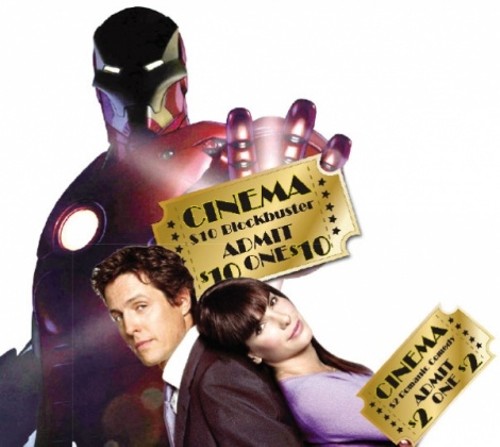It’s no breaking news to anyone who follows the movie industry—or anyone who looks occasionally at the movie listings—that mainstream movies are directed overwhelmingly at teenage boys. Exactly how long that’s been the case, and to what extent it has gotten worse in recent years, is up for constant debate. In a recent GQ article, film journalist Mark Harris traces the trend back to Top Gun in 1986; plenty of others have pointed to the Star Wars summer of 1977. But however and whenever it began, there’s little question that Hollywood now depends on serving the young male audience—as a seemingly nonstop buffet of comic-book and video-game adaptations bears constant witness.
On the surface, it’s easy to understand why. Perhaps more so even than other large industries, the American movie industry is run based on fear of the potential fallout of doing something different and having that something different fail. Young singles on dates and fantasy fanboys are about the only sure thing when it comes to a theatrical audience anymore, which makes it seem like common sense for Hollywood to base its economy around them. But while the landscape of media consumption continues to change by the hour—a reality of which the music, publishing and news-media industries are all too painfully aware—the film-exhibition industry continues to operate roughly the same way it has for the past 40 years.
And what’s remarkable is, they haven’t learned the most obvious lesson of the 21st century 3-D boom, as well as the first rule of economics: The price of a product should reflect what the market will bear. Premiums for 3-D films have kept the revenue stream for theatrical box-office income relatively stable, even as overall ticket sales dropped around 5 percent in 2010 over the previous year. It’s clear that the exhibition industry has figured out that demand/ticket price interaction moves in one direction. So why haven’t movie theaters considered the most obvious inverse: charging lower ticket prices for movies that might need a little boost getting people into the seats?
Here’s the simple reality: Adults aren’t going to movies, and mainstream studios aren’t making movies for adults. It feels like a chicken-and-egg conundrum, except that it’s astoundingly easy to solve. The making and marketing of adult-targeted dramas and comedies costs a fraction of what it takes to make a summer action blockbuster, and there’s a completely different demand by the audience to see those two types of films as soon as they hit theaters. Yet whether you want to see The King’s Speech or Iron Man 2, you’ll pay the same $9. No other type of live entertainment is this absurd in its pricing structure. If your local music club tried to charge the same $150 to check out a local band that you’d pay to see U2 or Taylor Swift, potential patrons would create a cartoon-like cloud of dust fleeing in the opposite direction, all while laughing hysterically. Yet, we don’t even blink at theaters doing the same thing, because it’s a ridiculousness we’re so used to.
In that spirit, here’s a modest proposal: Charge people what they’re actually prepared to pay for a movie. If the audience for a 3-D action movie is already demonstrating its willingness to shell out more than $10 for the experience, by all means, continue down that fruitful path. But if you’re trying to get people to come to a lower-budget romantic drama, make the ticket price $2. Not just for matinees, but for every ticket, all day. Then advertise the living hell out of that fact. If adults are all-too-often prepared to wait out a movie’s theatrical run because they can see it more cheaply at home on pay-per-view or DVD, give them an incentive to see it right now, and for less. I’m guessing they’ll still go to the snack bar, too.
And just this past weekend, there was evidence that “discount movies” works as a marketing tool. According to a MovieWire report, Lionsgate Films partnered with Groupon for the opening weekend of The Lincoln Lawyer, bringing in 40,000 moviegoers—the vast majority of them adult women—at $6 a ticket. Of those attendees, 89 percent said they wouldn’t have gone to the movie without the reduced price.
Of course, distributors would need to collaborate with exhibitors to make this a reality. But imagine the market the industry could resurrect from the dead, while maybe even making better movies in the process. And then, Mr. or Mrs. Grown-Up Movie-Goer, you suddenly might not feel so alone anymore.
Speaking of...
-
Salt Lake Comic Con 2016 Day 1: Circus Maximus
- Sep 2, 2016
-
If May the 4th *must* be with you...
- May 4, 2015
-
In The Loop: 5/2/15. Finding Art Everywhere You Go!
A look at cool events from May 3-16.
- May 2, 2015
- More »
More by Scott Renshaw
-
Film Reviews: New Releases for April 19
The Ministry of Ungentlemanly Warfare, Abigail, The Beast, Hard Miles, Sasquatch Sunset and more
- Apr 19, 2024
-
Faces of Salt Lake County book and portrait reception
Images and personal stories in a new book reveal local demographic diversity
- Apr 17, 2024
-
Feature film review: THE BEAST
A filmmaker's compelling ideas get a bit tangled in references to his creative influences.
- Apr 17, 2024
- More »
Latest in Film Reviews
Readers also liked…
-
Power Plays
Two satirical comedies explore manipulations and self-delusions by those with power.
- Aug 31, 2022




